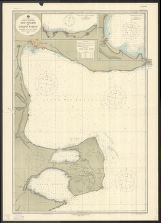Description
Relief shown by hachures.Soundings shown in fathoms.Hand colored.Prime meridian: Ferro and London.Insets: The harbour of Bluefields [ca. 1:95,000] -- The harbours of Kingston and Port Royal [ca. 1:95,000]Exhibited in “Faces and Places,” at the Boston Public Library, Boston, MA, October 2003 - September 2004. MB (BRL)improved and engraved by Thomas Jefferys.Discovered by Christopher Columbus in 1494, Jamaica was a Spanish colony until 1655 when it was taken over by the British. The third largest island in the West Indies, it became the focus of British activity in the Caribbean. Its economy was dominated by sugar production based on slave labor imported from Africa. Details on this 1775 map by the British geographer and publisher Thomas Jeffreys record the racial segregation that was institutionalized during the British colonial regime. Underlining distinguishes what are referred to on the map as "Negro-towns," most of which are situated in the less hospitable mountainous interior. In contrast, the flatter coastal areas, which were more suitable for agriculture, are dotted with small squares and circles, symbolizing the British-owned sugar plantations and sugar mills. In addition, the map's two insets depict the topography and hydrography of the island's busiest ports, Kingston and Bluefields, which had become centers of British colonial administrative and mercantile activities.
Image
Maps
No known copyright restrictions.No known restrictions on use.













![Map of New-York Bay and Harbor and the environs : [with colored manuscript additions to show positions of troops and fleets at the Battle of Long Island, 1776] Map of New-York Bay and Harbor and the environs : [with colored manuscript additions to show positions of troops and fleets at the Battle of Long Island, 1776]](https://d2l9jrtx1kk04i.cloudfront.net/861b59bb0ac04500efd22c07eb61e9424fa0dae6.png)







